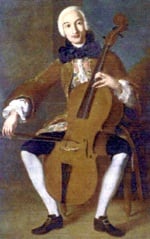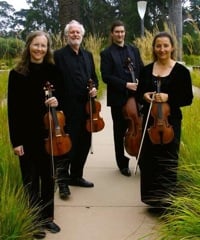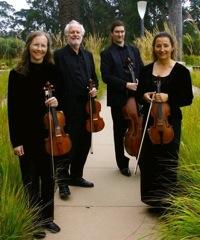
circa 1764-1767
The quartet — Kati Kyme and Lisa Weiss on violins; Anthony Martin, viola; and William Skeen, cello — brought in Elizabeth Le Guin, as the additional cellist. They played on original instruments with Baroque bows positioned some distance away from the frog, with gut strings, no chin rests, and no pegs. Together they made as fine and substantive a professional group of string players as audiences are likely to hear anywhere. The evening’s repertoire consisted of four cello quintets culled from the 143 such works that Boccherini wrote in his lifetime (out of no fewer than 589 completed compositions).
The first thought that came to mind as I listened was how different the works were from one another. Unlike Vivaldi, for example, who is occasionally accused of writing only one concerto 500 times, the four Boccherini quintets I heard stood entirely independent of each other. Even more remarkable is the fact that they were subtly, though distinctly, different from the chamber music produced in what was then the center of gravity for chamber music: Vienna. For example, the thematic material had its own stamp; the harmonic motion was idiosyncratic; and instrumental presentations were singular (such as cello parts written in the range of the violins, on occasion). Nowhere in their chamber music did Haydn, Mozart, Beethoven, or Schubert handle things in this fashion.
I hypothesize that Boccherini (1743-1805), an Italian who spent most of his musical and compositional life in Spain, separated from the Viennese milieu, evolved differently than his contemporaries, for the same reason that the animals in the Galapagos differed from each other, island by island.
Not varying from the excellence on display was the added artist, Elisabeth Le Guin, who not only is a superb Baroque cellist, but is also a musicologist and teacher (at UCLA) and a winner of the Alfred Einstein award for her 2002 article on Boccherini published in the prestigious Journal of the American Musicological Society. Her most recent book, Boccherini’s Body: An Essay in Carnal Musicology, boasts a delicious title, and I’ll get to it soon. She also maintains a Web site with period criticism of the composer and downloadable recordings of his music.
Discombobulated, in a Good Way

During the brief intermission, I examined the performance parts used by the players and was surprised to see that they were executing from an early French edition of Boccherini’s music, printed in the first quarter of the 19th century. But with work under way for a new, complete edition of Boccherini’s music, the difficulties of dealing with the peculiarities of early editions will someday be ameliorated.
It should be no surprise that from time to time Boccherini’s music shows up in movies. It was the music played in The Ladykillers (1955), starring Alec Guinness, Herbert Lom, and Peter Sellers. The thieves, planning a robbery, hid their activities behind a recording of the Minuet from Boccherini’s String Quintet in E Major, G. 275, all the while pretending to be a group of string players practicing for a concert.
More recently, the movie Master and Commander (2003) had actor Russell Crowe playing a violin in excerpts from Boccherini’s String Quintet in C Major, G. 324, amid his duties captaining a British warship. I remember being charmed by the few passages Crowe played when not beating up on the French, and wondered who might have written such engaging music. Well, at least someone was paying attention to Boccherini — for I was not. My loss: It won’t happen again.

